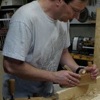Have recently read a few threads on workbenches including this current one http://www.sawmillcreek.org/showthre...ench-questions. A standard reply is "X said in his book that you should use the pinky test"
So where did this "pinky test" idea come from? I have used a few different benches in various shops (over 20+ years) including one that was ~120-30 years old and I don't think I have ever seen a bench as low as what the "pinky test" would give for the average adult male. Most older benches I have seen have been around the 32" height. Did a quick review just to check my gut feeling and came up with the following points(nothing new here I know).
Scott Landis in his workbench book quotes heights for period Nicholson and Roubo benches at 32" and 31 3/4" respectively with 18th and 19th century American benches ranging from 28 to 33".
If these early benches were optimised for hand planing it was for wooden planes so the above heights are too low if you are using Bailey style planes.
There is statistical data to suggest that in general todays population (in the western world at least) is higher than that of the 18th and 19th century.
If we use the premise that 18th and 19th century wood workers worked on benches that were perfectly tuned to their stature and the nature of work carried out (this seems to be a popular idea but also slightly flawed I think), and that the heights quoted by Landis for period benches are correct then those same 18th and 19th century woodworkers would I think be a bit bemused by the idea of the "pinky test"
So enough theory and having tried it in practice - (being a pretty fit male of average height and proportions) I would hate to work (and that includes planing) on a "pinky test" bench. Personally I think the "pinky test" is at best a non-ideal way to to choose your ideal bench height and at worst a crock.
Discuss ...




 Reply With Quote
Reply With Quote





